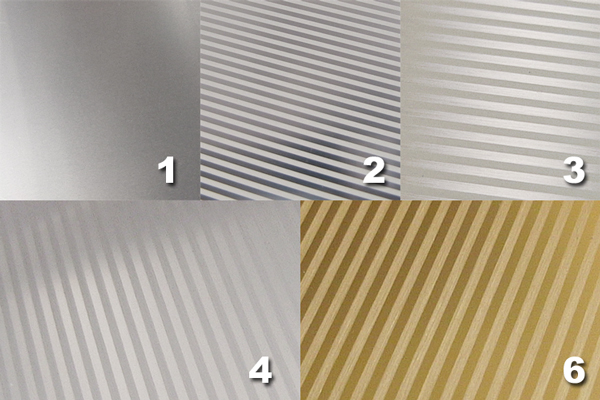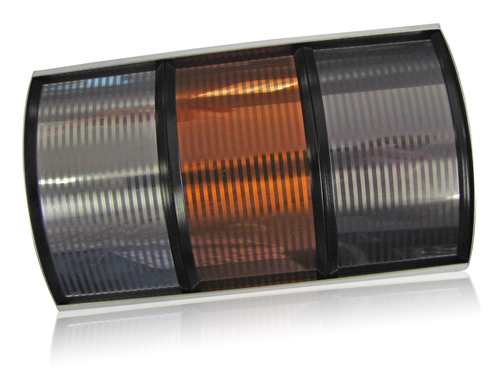irRESISTable Aluminum
Can you resist metal? We can!
Resist. Let me clarify, a resist or mask is printed on aluminum to protect areas of metal during the brushing process. The protected areas of metal remain bright aluminum. The resist process can be used repeatedly on the same finish to create metal finishes with multiple brush directions. Brushed aluminum is a preferred look because it is an authentic material. Applying a brush selectively allows you to use your imagination creating finishes with movement and detail.
This article is the first in a series of four articles on using a resist with mechanical finishes on aluminum. This articles focuses on the screen printed resist process.
Brushed Aluminum

- bright aluminum - a polished surface from the mill
- resist - a screen printed mask for protection
- brush - mechanically abrade the surface of the metal
- wash - remove the resist or mask
- repeat - steps 2-4 as needed changing the brush direction
- color - print overall or selective color
Key to the success of this process is the resist. Resist must be robust enough to stand up to the mechanical brushing process. It then needs to be easily removed from the metal revealing the protected areas. A resist is also used with other mechanical finishes such as engine turn or spin allowing these finishes to be applied selectively to metal.
When multiple brush directions are integrated into a finish, the brushes are typically applied in a horizontal and vertical direction. However, brushes can also be applied at an angle if needed. Angled brushes might be used when more than two brush directions are required. They are also used to create subtle movement or to align to specific graphic details.

Screen Printed Resist on Aluminum
Many of our aluminum finishes rely on a resist to allow selective application of mechanical finishes. The process is often used in nameplates to create bright graphics. The resist is often the base process when decorating metal. All other decorative processes build off of it. You might say we can't resist using resist!
How would you use the printed resist process in a pattern? Would you layer opaque and transparent color on top of selective brushing? Would you add a printed texture?
Request aluminum finishes which include selective brushing to see how the resist process is used to add interest to finishes.
Subscribe to Design Blog
- 2021 (1)
- 3D (5)
- Aluminum (88)
- Aluminum In-mold (3)
- Aluminum Trim (87)
- Anodize (2)
- Appliance (5)
- Architectural (9)
- Art Deco (4)
- Automotive (15)
- Black Finish (2)
- Boats (1)
- Brushed Aluminum (25)
- Carbon Fiber (11)
- Ceiling Tile (3)
- Classic (2)
- Coating (1)
- Coined (3)
- Color Development (2)
- Color Trend (2)
- Copper Finish (2)
- Cosmetics (2)
- Custom Patterns (49)
- Customization (7)
- Customized Patterns on Aluminum (2)
- Decorated Metal Cards (1)
- Diamond Cut (2)
- ebook (8)
- Faux Finishes (20)
- Favorite Finish (19)
- Fine Art (5)
- geometric (1)
- Geometric Finish (8)
- Gloss (3)
- Gold Finish (2)
- gray (4)
- Holiday Card (3)
- IDSA (3)
- Inlay (4)
- Large Format (3)
- linear (2)
- Linear Finish (6)
- Lithography (2)
- Match Box Cover (4)
- Materials and Processes (29)
- Mechanical Finishes (37)
- Metallic (2)
- Micro Finish (4)
- Modern (2)
- Mood Board (30)
- Nameplate (3)
- NeoCon (1)
- Organic Finish (2)
- Organic Finishes (13)
- Patina Finish (12)
- Pattern on Pattern (1)
- Powerful (2)
- Process Color (6)
- Promotional Products (13)
- Recycled Aluminum (3)
- Resources (12)
- Selective Patterns (9)
- Silver Finish (7)
- Simplicity (2)
- Stainless Steel (3)
- Surface Collection (32)
- Surfaces (87)
- Technical (11)
- Texture (15)
- Top 10 (9)
- Top 3 (1)
- Watermark (2)
- White Finish (3)
- Woodgrain (7)
- Worn (3)
- Woven Finish (6)



